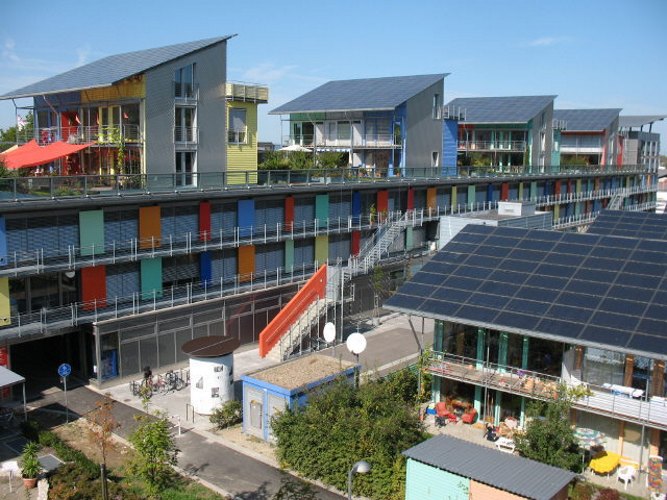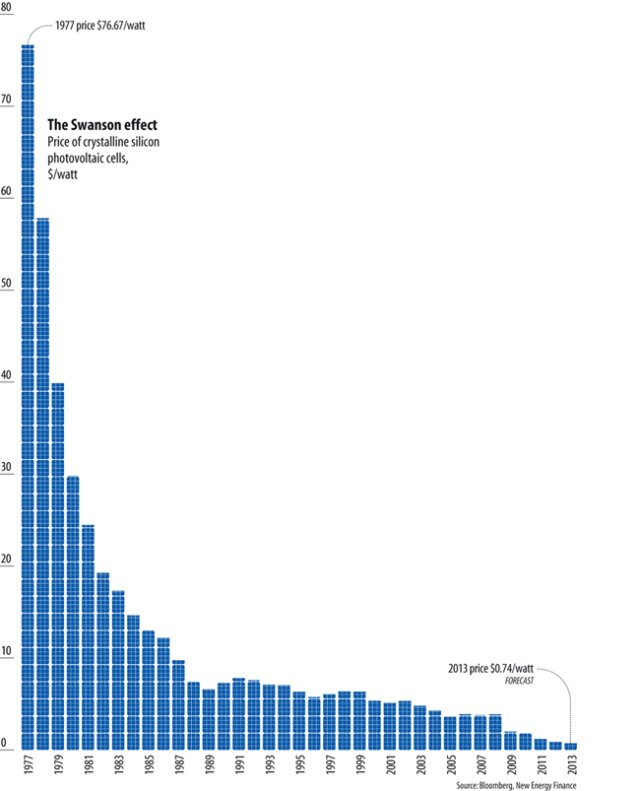
Goldman Sachs says declining prices of solar plus battery storage means that by 2033 homeowners will no longer need to be on the grid in U.S. And that will happen sooner in expensive electricity states like New York and California. This projection tracks well with the recent Rocky Mountain Institute report (Nuclear Newsreel, February 25, 2014) on grid defection. As RMI subsequently pointed out (The utility death spiral, stupid utilities and grid defection) grid defection is not necessarily a good thing. But homeowners need not actually disconnect from the larger grid to take advantage of the plunging prices of rooftop solar and the upcoming similar price plunges for battery storage expected from Tesla’s massive battery production plant being planned.
That’s the good news for utilities; the bad news for them–and the good news for the climate–is that as homes and businesses increasingly become self-powered and even able to send excess power back to the grid, the need for large “baseload” nuclear and fossil fuel plants will become less and less. Utilities planning expansion of large reactors (e.g. Vogtle and Summer) and continued operation of increasingly-expensive aging reactors will be in trouble in this new marketplace. And the odds that reactors that already have obtained 20-year license renewals will actually operate for those extended periods are dwindling. License renewals are pieces of paper, they’re not assurance of economic operation–if there is no market for the electricity they’re generating, utilities won’t run them. And since we’re talking odds here, the idea now being bounced around the NRC, DOE and some in the nuclear industry of further license extensions to allow 80-year operation of reactors increasingly appears to be a genuinely silly concept.

This is what is behind efforts by backward utilities like Entergy and Exelon that are heavily invested in nuclear reactors to rig electricity rates to favor nuclear power (Activists pay attention: the nuclear industry wants to rig your rates). They know the long-term trends are running against them, and even in the short-term their reactors are failing to compete in the new marketplace. That inability to compete is only going to accelerate. It’s one thing to be unable to compete with alternative generation like natural gas and wind, which is their current problem. It’s quite another to be unable to compete with tens of millions of homeowners and businesses putting up solar panels on their roofs and backing up that power with battery storage. No amount of electricity price-rigging can compensate for that–in fact, higher electricity rates for nuclear power will only encourage faster adoption of rooftop solar. Most of those customers will stay connected to the grid to ensure stability and greater reliability, but they won’t be buying much power, certainly not the levels needed to keep behemoth reactors operating.
A different kind of effort by nuclear utilities to prevent the inevitable can be seen in California, where SolarCity has accused Pacific Gas & Electric (PG&E) of blocking a pilot program of solar plus battery storage installations. That approach is even less likely to work over even the short-term than the efforts of Exelon and Entergy. But PG&E is desperate to avoid shutdown of its Diablo Canyon reactors, at least before their initial licenses expire in the next decade, so it’s trying whatever it can. License extension of those reactors seems increasingly unlikely, given the level of opposition to Diablo Canyon in California and the unfavorable long-term prospects for nuclear in the state. An early shutdown now appears far more probable than 20 more years of operation.
But even if a cleaner and cheaper energy future powered increasingly by renewable distributed generation sources appears increasingly inevitable, the efforts by nuclear utilities to delay that future will be painful–economically, potential for nuclear accidents, unnecessary radioactive waste generation–if successful. That’s why activists–and just concerned people everywhere–need to stay on top of these developments and take action to oppose the utilities when appropriate. If you’re not already on NIRS e-mail alert list, join now to do just that.
Michael Mariotte
March 18, 2014
Permalink: https://www.nirs.org/2014/03/18/goldman-sachs-sees-a-solar-future/
You can now support GreenWorld with your tax-deductible contribution on our new donation page here. We gratefully appreciate every donation of any size–your support is what makes our work possible.
Comments are welcome on all GreenWorld posts! Say your piece above. Start a discussion. Don’t be shy; this blog is for you.
If you like GreenWorld, you can help us reach more people. Just use the icons below to “like” our posts and to share them on the various social networking sites you use. And if you don’t like GreenWorld, please let us know that too. Send an e-mail with your comments/complaints/compliments to nirs@nirs.org. Thank you!
Note: If you’d like to receive GreenWorld via e-mail daily, send your name and e-mail address to nirs@nirs.org and we’ll send you an invitation. Note that the invitation will come from a GreenWorld@wordpress.com address and not a nirs.org address, so watch for it.




Headline: “by 2033 homeowners will no longer need to be on the grid in U.S.”
Text within article: “Most of those customers will stay connected to the grid…”
Good article-makes alot of sense.
Yes, there are clear advantages to staying on the grid if for no other reason as a backup to the backup battery power. Just because homeowners can be self-sufficient doesn’t mean they will choose to do so. In addition, especially in many urban areas, some power power plants still will be needed–rooftop solar isn’t going to power the world by itself. That the nature of those power plants will change–smaller plants than the 1,000 MW reactors or even 500 MW coal plants of today and more of them, and most powered by wind or solar, with some geothermal, etc added in. Homeowners staying on the grid will improve grid stability.
Unless there is a breakthrough in Physics within 15 years or less the concept of SMR will finally be put to bed, as ever more R&D is being terminated, here is the latest example:
Babcock & Wilcox scaling back work on small modular nuke program
http://www.snl.com/InteractiveX/article.aspx?CDID=A-27763880-11051&ID=27763880&Printable=1
For the Utilities that run them, nuclear power plants are a cash cow that guarantees them an income stream for about 100 years when building, running and decommissioning are all included! Note:That this does not include all the rate increases and BIG replacement projects needed along the way, that will add many billions more to what the Utility generates (pun intended) for themselves and their shareholders!
Knowing what we know now about “just” rooftop solar, it is a good bet that in 30 to 40 years if these nuclear power plants ever do get built, they will become a hugely expensive boondoggle that the people cannot afford!
Excerpts from:
http://cleantechnica.com/2014/04/15/greenest-source-power-french-response-low-carbon-strategy/#
John Hughes – I agree, in twenty years solar panels will be just like vinyl windows are today, used everywhere because they make so much sense and save so much wasted energy!
I also look to ever more eVehicles and their batteries plus any additional batteries (that I believe Companies like Tesla will soon market), will form a homes energy storage “mini-grid” in order to make use of as much of its locally generated energy as possible, especially for those that have good jobs and/or homes with large roofs. This is now happening in the Sunbelt and it will spread since people are no longer willing to pay huge amounts of money for something they can generate at home.
By NOT building new nuclear power plants like those that were being considered in Flordia the people will save many Billions of dollars!
It is amazing to me that the nuclear industry always wants to sideline the radioactive waste issue until sometime in the far distant future so that they don’t have to deal with it…
Also, unmentioned is IF there are no cost over runs and/or IF nothing goes BAD before they are fully decommissioned over half a century later…
Those are two BIG IF’s that make building new nuclear no longer cost effect, unless someone is getting paid to push the plan for the Utilities who hope to profit from them…
+
For the Utilities that run them, nuclear power plants are a cash cow that guarantees them an income stream for about 100 years when building, running and decommissioning are all included! Note: That this does not include all the rate increases and BIG replacement projects needed along the way, that will add many billions more to what the Utility generates (pun intended) for themselves and their shareholders!
Knowing what we know now about “just” rooftop solar, it is a good bet that in 30 to 40 years if these nuclear power plants ever do get built, they will become a hugely expensive boondoggle that the people cannot afford!
Excerpts from:
http://cleantechnica.com/2014/04/15/greenest-source-power-french-response-low-carbon-strategy/#
Lets not let our past nuclear shortsightedness keep US from looking at other solutions that do not require the use of RISKY nuclear and/or the generation of additional nuclear waste which mankind will have to deal with for generations, whose total cost both fiscally and environmentally are as yet unknown.
Solar in the form of Wind is good, but when Ocean-water Current and/or Tidal generation comes online then it will be a game changer since it will provide 24/7 TRULY GREEN energy in very large quantities.
Soon to be deployed:
The Tide Is High · Lockheed Martin:
http://www.lockheedmartin.com/…
and in the near future perhaps even this new form of generation:
Global Sustainable Electricity, Fresh Water, and Deep-Ocean Mining from Marshall Hydrothermal http://shar.es/T5Dai
If we enable engineers to examine all solutions with equal funding, then 10 to 20 years from now there will be no need for aging nuclear reactors unless there is a fundamental breakthrough in physics…
Excerpts from: http://theenergycollective.com/jessejenkins/368706/can-nuclear-power-and-renewable-energy-learn-get-along#comment-127091